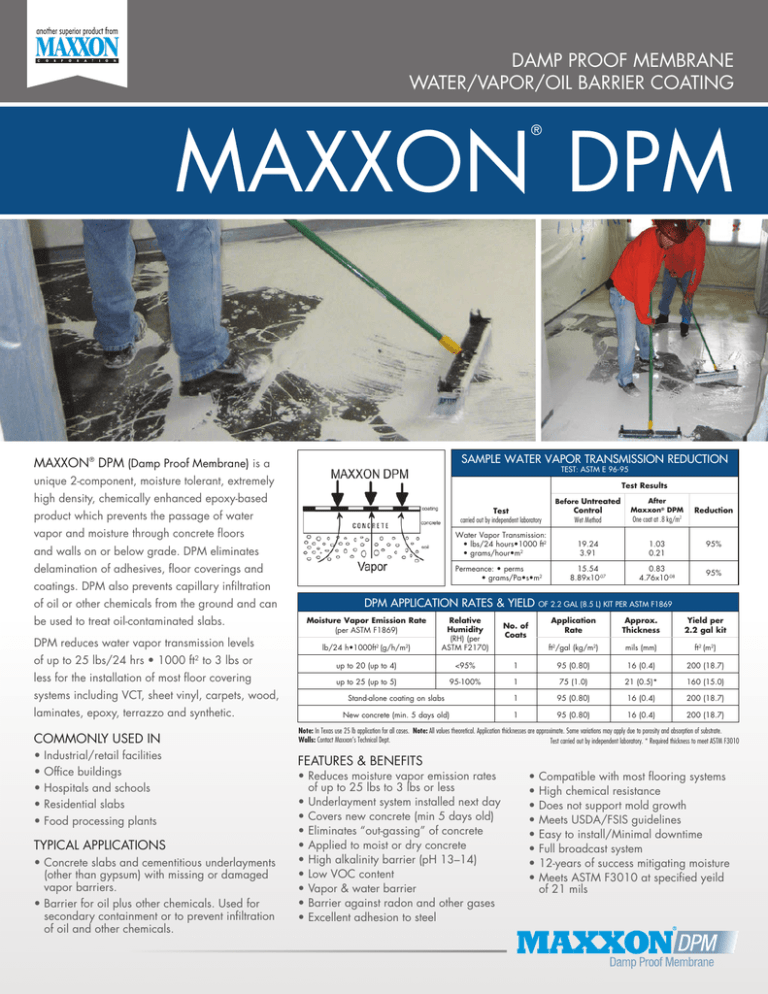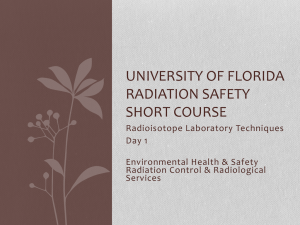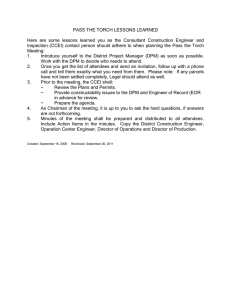
DAMP PROOF MEMBRANE
WATER/VAPOR/OIL BARRIER COATING
MAXXON DPM
®
SAMPLE WATER VAPOR TRANSMISSION REDUCTION
MAXXON® DPM (Damp Proof Membrane) is a
TEST: ASTM E 96-95
unique 2-component, moisture tolerant, extremely
Test Results
high density, chemically enhanced epoxy-based
Test
carried out by independent laboratory
product which prevents the passage of water
vapor and moisture through concrete floors
and walls on or below grade. DPM eliminates
delamination of adhesives, floor coverings and
coatings. DPM also prevents capillary infiltration
of oil or other chemicals from the ground and can
be used to treat oil-contaminated slabs.
DPM reduces water vapor transmission levels
of up to 25 lbs/24 hrs • 1000 ft2 to 3 lbs or
less for the installation of most floor covering
systems including VCT, sheet vinyl, carpets, wood,
laminates, epoxy, terrazzo and synthetic.
COMMONLY USED IN
•
•
•
•
•
Industrial/retail facilities
Office buildings
Hospitals and schools
Residential slabs
Food processing plants
TYPICAL APPLICATIONS
•C
oncrete slabs and cementitious underlayments
(other than gypsum) with missing or damaged
vapor barriers.
• Barrier for oil plus other chemicals. Used for
secondary containment or to prevent infiltration
of oil and other chemicals.
lb/24 h•1000ft2 (g/h/m2)
Control
Wet Method
After
Maxxon® DPM
One coat at .8 kg/m2
Water Vapor Transmission:
• lbs/24 hours•1000 ft2
• grams/hour•m2
19.24
3.91
1.03
0.21
Permeance: • perms
• grams/Pa•s•m2
15.54
8.89x10-07
0.83
4.76x10-08
DPM APPLICATION RATES & YIELD
Moisture Vapor Emission Rate
(per ASTM F1869)
Before Untreated
Relative
Humidity
(RH) (per
ASTM F2170)
No. of
Coats
Reduction
95%
95%
OF 2.2 GAL (8.5 L) KIT PER ASTM F1869
Application
Rate
Approx.
Thickness
Yield per
2.2 gal kit
ft2/gal (kg/m2)
mils (mm)
ft2 (m2)
up to 20 (up to 4)
<95%
1
95 (0.80)
16 (0.4)
200 (18.7)
up to 25 (up to 5)
95-100%
1
75 (1.0)
21 (0.5)*
160 (15.0)
Stand-alone coating on slabs
1
95 (0.80)
16 (0.4)
200 (18.7)
New concrete (min. 5 days old)
1
95 (0.80)
16 (0.4)
200 (18.7)
Note: In Texas use 25 lb application for all cases. Note: All values theoretical. Application thicknesses are approximate. Some variations may apply due to porosity and absorption of substrate.
Walls: Contact Maxxon’s Technical Dept.
Test carried out by independent laboratory. * Required thickness to meet ASTM F3010
FEATURES & BENEFITS
•R
educes moisture vapor emission rates
of up to 25 lbs to 3 lbs or less
• Underlayment system installed next day
• Covers new concrete (min 5 days old)
• Eliminates “out-gassing” of concrete
• Applied to moist or dry concrete
• High alkalinity barrier (pH 13–14)
• Low VOC content
• Vapor & water barrier
• Barrier against radon and other gases
• Excellent adhesion to steel
•
•
•
•
•
•
•
•
Compatible with most flooring systems
High chemical resistance
Does not support mold growth
Meets USDA/FSIS guidelines
Easy to install/Minimal downtime
Full broadcast system
12-years of success mitigating moisture
Meets ASTM F3010 at specified yeild
of 21 mils
TECHNICAL DATA
Material���������������������������������������������� 2-component epoxy
Color����������������������������������������������������������������������� White
Density�������������������������������������� 14.66 lbs/gal (1.76 kg/L)
VOC Content, mixed�����������������������0.39 lbs/gal (47 g/L)
Volume Solids������������������������������������������������������� 97.3%
Flash Point: Part A����������������������������� >212 °F (>100 °C)
Part B����������������������������������� 170 °F (77 °C)
Mixing Ratio��������������������������������������� 100:12 (by weight)
Pot Life, approx���������������������60 Minutes at 75 °F (24 °C)
30 Minutes at 85 °F (30 °C)
Open to Foot Traffic�����������after 12 hours at 73 °F (23 °C)
Curing Temperature������������������������minimum 46 °F (8 °C)
Full Strength��������������������������after 7 days at 73 °F (23 °C)
Compressive Strength�������������� >11,000 psi (>75.8 MPa)
ASTM D695
Flexural Strength����������������������� >4,300 psi (>29.6 MPa)
ASTM D790
Adhesion to:
• new concrete (5 days)��������������������������� 110 psi (0.8 MPa)
• moist concrete (28 days)������������������������ 550 psi (3.8 MPa)
• dry concrete (28 days)�������������������������� 580 psi (4.0 MPa)
ASTM D-4541 (modified) failure in substrate
Temperature Resistance
Continuous:
• dry heat���������������������������������������������������� 140 °F (60 °C)
• humid������������������������������������������������������� 113 °F (45 °C)
Intermittent:
• high pressure water������������������������������������ 185 °F (85 °C)
248 °F briefly (120 °C)
• dry heat���������������������������������������������������� 140 °F (60 °C)
All data are average values obtained under laboratory conditions. In practical use temperature,
humidity and absorbance of the substrate may influence the above given values.
WATER VAPOR EMISSION TESTING
Maxxon strongly recommends determining the RH content (%)
on slabs to be treated using in situ probes, as per ASTM F2170.
Alternatively, Anhydrous Calcium Chloride testing may be used as
to determine the MVER (moisture vapor emission rate) in lb/24 hrs
• 1000 ft2 (grams/hr • m2) as per ASTM F1869-98. The testing
must be carried out before application of DPM to obtain Maxxon
warranty. Note: MVER fluctuates within slab areas, and can have
significant seasonal variations (i.e. 6 lbs. in Nov/Dec and 16 lbs.
or more in July/Aug).
For concrete slabs with emission rates from 20 to 25 lb/24
hr • 1000 ft2 (4 to 5 grams/hr • m2), it is required that a test
application be conducted with DPM to verify acceptable MVER
levels and structural soundness of the concrete slab. Consult our
technical department before applying DPM to concrete slabs with
compressive strength of less than 2,500 psi (17.2 MPa). A test
application is recommended on old slabs where a sealer may be
present.
TESTING FOR CONTAMINANTS
Request owner of facility to test slabs with unknown history
(i.e. old slabs, existing floor failures, etc.) for contaminants (i.e.
hydrocarbons, other organic compounds, unreacted silicates, ASR,
sulfurous compounds; 2,500 psi (17.2 MPa) compressive strength,
etc.) to determine suitability for DPM. Provide Ion Chromography
and IR Spectroscopy data to Maxxon before commencing
application.
PREPARATION OF SUBSTRATE
All concrete surfaces with moisture to be treated with DPM must
be clean, sound and have an “open”/absorptive surface (“tooth
and suction”). Do not apply DPM to surfaces which have been
previously treated with any kind of sealer.
WATER VAPOR TRANSMISSION TREATMENT
1. R
emove existing floor coverings, coatings, adhesives, curing
compounds, efflorescence, dust, grease, laitance, etc. down
to bare concrete with steel shot blasting, scarifying or grinding
using a diamond cup blade (run with low RPM and assure that
surface is profiled). Standard acid etching is NOT allowed.
2. S
hot blast or abrasive blast concrete slabs to surface profile ICRI
CSP 3–5.
SEALING OF EXPANSION JOINTS IN CONCRETE SLABS
•
•
•
•
•
•
oat slab surface with Maxxon DPM per specifications
C
Coat sidewalls and bottom of cavity with Maxxon DPM
Allow Maxxon DPM to cure for minimum 12 hrs at 73 °F (23 °C)
Install backer rod
Fill cavity with a polyurethane sealant or as specified by the architect/engineer
Install sub-flooring system
SEALING OF SAW CUT JOINTS IN CONCRETE SLABS
Concrete less than 6 months old:
• Coat slab surface with Maxxon DPM
per specifications
• Coat sidewalls and bottom of cavity
with Maxxon DPM
• Fill cavity with a polyurethane sealant
• Install sub-flooring system
3. Burn off reinforcing fibers and vacuum remains.
4. R
epair cracks with a suitable patching mortar or DPM
broadcasted with sand.
5. T reat saw cut and expansion joints as per Installation
Guidelines.
6. C
arefully pre-dampen all the prepared surfaces to be treated
2-3 times with clean water to SSD (saturated surface dry).
Leave no standing water!
7. Install cementitious underlayments, leveling mortars, flash
patching, on top of DPM.
OIL CONTAMINATED SLABS
Selecting of appropriate remediation: Citrus based degreasing
agents work well for hydrocarbon contaminated slabs containing
low to medium amounts of oil. However, if several degreasing
cycles do not show satisfactory results, or the IR analysis reveals
high concentrations of hydrocarbons, the solution points to
microbial remediation. Cultivated microbes or “bugs” eat oil and
other organic substances such as paraffin, grease, creosote, and
aromatic hydrocarbons.
1. D
e-greasing: After steel shot blasting, treat surface with a degreasing cleaning agent by the detergent scrubbing method as
outlined in ICRI Guideline No. 03732. Use as many cleaning
cycles as necessary. Check after a minimum of 5 minutes with
undiluted de-greasing solution for discoloration. If it discolors,
carry out another de-greasing cycle and check. Dispose of the
oily wastewater in accordance with federal, state and local
regulations.
2. M
icrobial remediation: Follow microbial products
manufacturer’s instructions regarding application of microbes or
“bugs”. We strongly recommend carrying out a test application
of DPM for both remediation processes, prior to the actual
application of DPM.
3. C
lean treated surface with high pressure water blasting of
minimum 2,500 psi (17.2 MPa).
4. T he surface shall be damp/moist without standing water when
applying DPM. If the substrate dries before applying DPM, oil
can rise again and prevent DPM from bonding.
Concrete more than 6 months old:
•C
oat slab surface with Maxxon DPM
per specifications
•C
oat sidewalls and bottom of cavity
with Maxxon DPM
• Indoors: Fill cavity with quartz sand
• Outdoors: Fill cavity with a polyurethane
sealant
• Touch-up slab surface
• Install sub-flooring system
SAFETY
Refer to SDS. For commercial use only.
Part A - irritant; sensitizer – contains epoxy resins.
Part B - corrosive; sensitizer – contains amines.
Avoid contact with skin and eyes and prolonged inhalation. Wear
chemical resistant gloves and safety goggles. After contact with
skin, wash immediately with water and soap and rinse thoroughly.
In case of eye contact, rinse opened eye for several minutes
under running water and immediately seek medical advice. After
inhalation supply fresh air and call doctor for safety reasons. Use
NIOSH/MSHA approved vapor respirator in poorly ventilated
areas.
Spills: Ventilate area. Contain and collect spillage with
noncombustible, absorbent materials (i.e. sand, vermiculite,
universal binders, sawdust, etc.) and place in container for
disposal. Emergency procedures are not required. Dispose of
in accordance with current local, state and federal regulations.
VOC information: This product is well below the allowable EPA
limits as stated in 40 CFR Part 59.
KEEP OUT OF REACH OF CHILDREN.
LIMITED MATERIAL AND LABOR WARRANTY
This product is sold with the “standard” limited warranty described
below. A 10-year material and labor limited warranty is available
for emission rates up to 25 lbs/24 hrs • 1000 ft2 (5 grams/hr/
m2), when product is installed by a trained Maxxon dealer, or
the installation is factory inspected and approved. To qualify for
the limited warranty, application must be submitted and accepted
prior to installation of the product. The terms and conditions of that
limited warranty are contained in the application.
INSTALLATION DETAILS
For installation details, refer to the Maxxon DPM Installation
Guidelines available by contacting your Maxxon Regional
Representative at 800-356-7887.
LIMITED PRODUCT WARRANTY
See our website for complete warranty information.
PACKAGING AND SHELF LIFE
2.2 gal kit = 33 lbs (8.5 L = 15 kg), or
• 1.8 gal/29.5 lb (6.7 L/13.39 kg ) “A-Component” (resin)
• 0.4 gal/3.5 lb (1.8 L/1.61 kg) “B-Component” (hardener)
• Shelf life is 2 years in closed, original packaging,
stored in a dry, cool place.
Note:
• Post-cracking of the concrete, slab warping or warping relaxation at
joints or cracks after installation of the DPM may cause a breach in
the coating and void warranty.
• Assure that slab is thoroughly predampened to avoid formation of
pin holes.
• Cannot be mixed with Cab-o-Sil.
• Do not apply over gypsum based substrates.
Ask for your FREE
Moisture Mitigation
Comparison Guide
For more info: 800-356-7887 • Email: info@maxxon.com
www.MaxxonCorporation.com
Another superior product from:
Maxxon® Corporation • 920 Hamel Road • P.O. Box 253
Hamel, MN 55340 USA • 763-478-9600 • Fax: 763-478-2431
©1996-2015 Maxxon Corporation. All Rights Reserved. Maxxon DPM and associated logos are registered trademarks of Maxxon® Corporation, Hamel, MN, USA. Printed in the USA. #60057, TA500-5526, 9/15.


